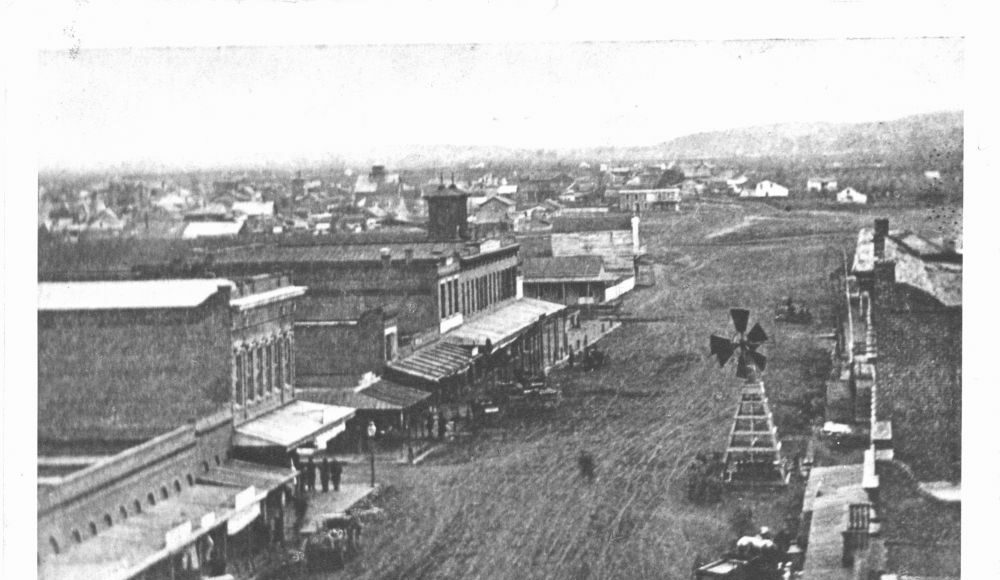Plaza de Cesar Chavez has transformed itself so many times, I can’t even keep track of it all.
This splotch of land runs deep. So deep, I will only scratch the surface of the dirt, with help from the ghost of late San Jose historian Clyde Arbuckle.
One of my favorite old photos of the land underneath Plaza de Cesar Chavez looks southward down Market Street in 1868, taken from the roof of the long-gone Hensley Hotel, a three-story brick structure that stood on the northwest corner of Market and Santa Clara. This is not the Hensley House Victorian that exists today. This was a different building altogether.
Major Samuel J. Hensley originally came to California in 1843 and was a captain during the Bear Flag Revolt. He owned a lot of land during San Jose’s initial years. Hensley Street is named after him.
The brick Hensley Hotel actually began in 1865 as the Masonic and Odd Fellows Building since Hensley was a charter member of the Howard Chapter No. 14 Royal Arch Masons of San Jose. Fraternal orders occupied the building until the earthquake of 1868, after which a few repairs resulted in renaming the building after Hensley. Then in 1880, Thomas Rea of Gilroy purchased the building and added two more stories to the top of it right as the San Jose Light Tower was being constructed at the very same intersection. For several more decades it was known as the Rea Building.
In textbook San Jose fashion, the Rea Building went through several name changes and tenants before it was smashed out of existence in 1941 and replaced with another building, a new-fangled Anglo California National Bank, which included a huge basement. Today the same building houses the San Jose Chamber of Commerce.
Are you still with me? Good.
In the 1868 photo looking south from Market and Santa Clara, the big open field beyond San Fernando Street, near the top right of the photo, is where the Tubes played 125 years later at Music in the Park. Thanks to this photo, however, we can see what remained of the old pueblo plaza after Chester Lyman’s famous 1848 map, when the plaza was simply called “Market Place.” We see a windmill at Market and El Dorado (now Post St.) which was used to power a water well. The two black towers a little above and left of center are part of the original St. Joseph’s Church, which burned down in 1875. The two-story building with wooden awnings at the far left is the Murphy Building, erected by Martin Murphy, Jr. in 1861 and used as a state courthouse in the mid-1860s.
Not too long after this, the closest thing to the modern plaza emerged, with a gargantuan city hall building, pretty much right where the fountains are today. What’s now Paseo de Antonio used to be an actual street that went right through the plaza and connected to Park Ave on the other side.
The City Hall building in Plaza Park was one of the most regal and grandiose buildings in San Jose history, until it was stupidly demolished in 1958. A new city hall then emerged at 801 N. First St.
Ever since then, even with tons of concerts and all sorts of activity, Plaza de Cesar Chavez is still massively underachieving. There should be a permanent infrastructure for public concerts and gatherings.
I am not here to point fingers, but Plaza de Cesar Chavez is the primary historical park of the whole damn city. It should be prioritized and modernized. And basic events shouldn’t require thousands of dollars in permits, border fencing and metal detectors.
As always, things are still transforming. Last Friday, Urban Confluence Silicon Valley hosted yet another meeting to discuss plans for a new public landmark in Plaza de Cesar Chavez. The irony was mind-blowing, as the meeting took place in the San Jose Chamber of Commerce offices, located at the same corner of Market & Santa Clara as the aforementioned Hensley Hotel and Rea Building.
Someday another photo will be taken from the roof of this building and the park will rise to glory again. By then, I just hope historians still exist to write about it.



